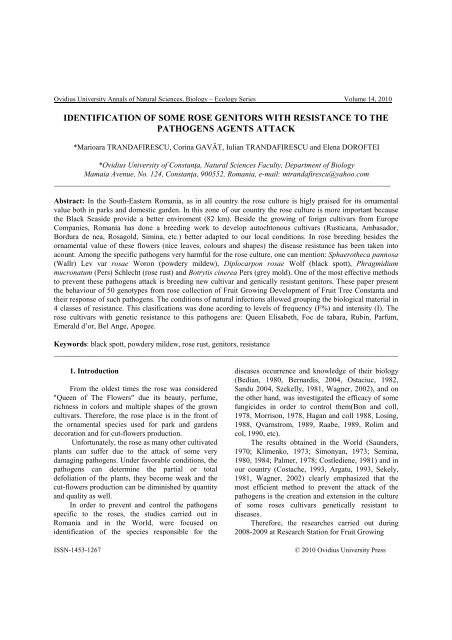VOLUM OMAGIAL - Facultatea de Ştiinţe ale Naturii şi Ştiinţe Agricole
VOLUM OMAGIAL - Facultatea de Ştiinţe ale Naturii şi Ştiinţe Agricole
VOLUM OMAGIAL - Facultatea de Ştiinţe ale Naturii şi Ştiinţe Agricole
You also want an ePaper? Increase the reach of your titles
YUMPU automatically turns print PDFs into web optimized ePapers that Google loves.
Ovidius University Annals of Natural Sciences, Biology – Ecology Series Volume 14, 2010<br />
IDENTIFICATION OF SOME ROSE GENITORS WITH RESISTANCE TO THE<br />
PATHOGENS AGENTS ATTACK<br />
*Marioara TRANDAFIRESCU, Corina GAVĂT, Iulian TRANDAFIRESCU and Elena DOROFTEI<br />
*Ovidius University of Constanţa, Natural Sciences Faculty, Department of Biology<br />
Mamaia Avenue, No. 124, Constanţa, 900552, Romania, e-mail: mtrandafirescu@yahoo.com<br />
________________________________________________________________________________________<br />
Abstract: In the South-Eastern Romania, as in all country the rose culture is higly praised for its ornamental<br />
value both in parks and domestic gar<strong>de</strong>n. In this zone of our country the rose culture is more important because<br />
the Black Seasi<strong>de</strong> provi<strong>de</strong> a better enviroment (82 km). Besi<strong>de</strong> the growing of forign cultivars from Europe<br />
Companies, Romania has done a breeding work to <strong>de</strong>velop autochtonous cultivars (Rusticana, Ambasador,<br />
Bordura <strong>de</strong> nea, Rosagold, Simina, etc.) better adapted to our local conditions. In rose breeding besi<strong>de</strong>s the<br />
ornamental value of these flowers (nice leaves, colours and shapes) the disease resistance has been taken into<br />
acount. Among the specific pathogens very harmful for the rose culture, one can mention: Sphaerotheca pannosa<br />
(Wallr) Lev var rosae Woron (pow<strong>de</strong>ry mil<strong>de</strong>w), Diplocarpon rosae Wolf (black spott), Phragmidium<br />
mucronatum (Pers) Schlecht (rose rust) and Botrytis cinerea Pers (grey mold). One of the most effective methods<br />
to prevent these pathogens attack is breeding new cultivar and genically resistant genitors. These paper present<br />
the behaviour of 50 genotypes from rose collection of Fruit Growing Development of Fruit Tree Constanta and<br />
their response of such pathogens. The conditions of natural infections allowed grouping the biological material in<br />
4 classes of resistance. This clasifications was done acording to levels of frequency (F%) and intensity (I). The<br />
rose cultivars with genetic resistance to this pathogens are: Queen Elisabeth, Foc <strong>de</strong> tabara, Rubin, Parfum,<br />
Emerald d’or, Bel Ange, Apogee.<br />
Keywords: black spott, pow<strong>de</strong>ry mil<strong>de</strong>w, rose rust, genitors, resistance<br />
__________________________________________________________________________________________<br />
1. Introduction<br />
From the ol<strong>de</strong>st times the rose was consi<strong>de</strong>red<br />
"Queen of The Flowers" due its beauty, perfume,<br />
richness in colors and multiple shapes of the grown<br />
cultivars. Therefore, the rose place is in the front of<br />
the ornamental species used for park and gar<strong>de</strong>ns<br />
<strong>de</strong>coration and for cut-flowers production.<br />
Unfortunately, the rose as many other cultivated<br />
plants can suffer due to the attack of some very<br />
damaging pathogens. Un<strong>de</strong>r favorable conditions, the<br />
pathogens can <strong>de</strong>termine the partial or total<br />
<strong>de</strong>foliation of the plants, they become weak and the<br />
cut-flowers production can be diminished by quantity<br />
and quality as well.<br />
In or<strong>de</strong>r to prevent and control the pathogens<br />
specific to the roses, the studies carried out in<br />
Romania and in the World, were focused on<br />
i<strong>de</strong>ntification of the species responsible for the<br />
diseases occurrence and knowledge of their biology<br />
(Bedian, 1980, Bernardis, 2004, Ostaciuc, 1982,<br />
Sandu 2004, Szekelly, 1981, Wagner, 2002), and on<br />
the other hand, was investigated the efficacy of some<br />
fungici<strong>de</strong>s in or<strong>de</strong>r to control them(Bon and coll,<br />
1978, Morrison, 1978, Hagan and coll 1988, Losing,<br />
1988, Qvarnstrom, 1989, Raabe, 1989, Rolim and<br />
col, 1990, etc).<br />
The results obtained in the World (Saun<strong>de</strong>rs,<br />
1970; Klimenko, 1973; Simonyan, 1973; Semina,<br />
1980, 1984; Palmer, 1978; Costlediene, 1981) and in<br />
our country (Costache, 1993, Argatu, 1993, Sekely,<br />
1981, Wagner, 2002) clearly emphasized that the<br />
most efficient method to prevent the attack of the<br />
pathogens is the creation and extension in the culture<br />
of some roses cultivars genetically resistant to<br />
diseases.<br />
Therefore, the researches carried out during<br />
2008-2009 at Research Station for Fruit Growing<br />
ISSN-1453-1267 © 2010 Ovidius University Press





